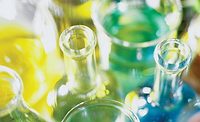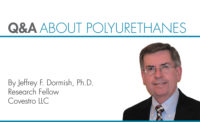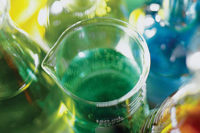Q&A About Polyurethanes
What types of surface preparation are necessary to obtain strong and durable bonds?
Having a clean surface is a key requirement to obtain a strong and reliable bond.

Companies using adhesives are expected to be able to consistently produce an assembly―whether in the flexible packaging, furniture, automotive or construction industry―without differences in the quality of the product manufactured. This is the case for both high-performance structural bonds and applications with lower performance requirements. Polyurethane adhesives can be formulated as a soft flexible polymer or one with high hard segment content with high tensile properties. Without a properly prepared surface to bond, however, the performance will not meet the expectations of the end user.
Having a clean surface is a key requirement to obtain a strong and reliable bond. Users of adhesives may remark that a drop in performance must be due to the adhesive manufacturer providing a sub-standard adhesive. The adhesive company may then go back to its raw material supplier and ask about the quality of polymers or reactive raw materials they have received. However, unexplained bond failures or variability in bond strength can be caused by inconsistent quality of the surface of the substrates being adhered. Coatings also often need a surface pretreatment to achieve optimal performance. They function to improve the long-term durability of a bond, not just initial bond strength. The type of surface preparation or primer depends on the substrates being bonded.
Typical metal-bonding adhesives require that surfaces be free of contaminants such as rust, oils and dust. Mechanical methods such as blasting, abrading the surface with a metal brush, or sandpaper can accomplish this. In order to promote paint adhesion, an acidic etching primer can be used, followed by a layer of polyurethane or epoxy primer. Solvent wiping or immersion will remove grease and oils.
The application of an electro-coating is also a typical surface treatment. Special epoxy adhesives used in automotive applications have been designed to bond to oily metal. It is difficult to substitute these adhesives with another polymer, due to this unique property and the high elevated temperature requirements for this application.
Many of the basic recommendations made for metal surfaces also apply to plastic substrates—the surface should be clean; in particular, it should be free of contaminants such as mold release agents and waxes. The adhesive’s surface energy should be lower than the substrate in order to achieve adequate wet-out of the adhesive and develop a strong bond. Polyurethane polymers are polar by nature and have a surface energy of
~ 38 dynes/cm, but this can vary depending on the exact structure of the polymer. Polyurethanes will bond to high-surface-energy substrates such as polyesters, polycarbonate and PVC without any special surface preparation. In contrast, some type of pretreatment or primer step needs to take place when adhering to low surface energy (~ 30 dynes/cm) polyethylene and polypropylene substrates. The surface energy of these polyolefins can be increased via flame, plasma or corona treatment. Chlorinated and chlorine-free polyolefin primers are also effective for improving adhesion. These primers are typically supplied in solvent, but waterborne analogs are also available. Polyurethane prepolymers delivered in solvents or at 100% solids are used as primers for a range of adhesives and coatings applications. For example, they can be used for improving bond strength to sheet molding compound and to increase corrosion protection of metal substrates.
Achieving a strong adhesive bond or a durable coating requires the manufacturer to supply a quality product and the proper use instructions, including application parameters, curing conditions and any potential surface preparation requirements. ASI
Any views or opinions expressed in this column are those of the author and do not represent those of ASI, its staff, Editorial Advisory Board or BNP Media.
Looking for a reprint of this article?
From high-res PDFs to custom plaques, order your copy today!






